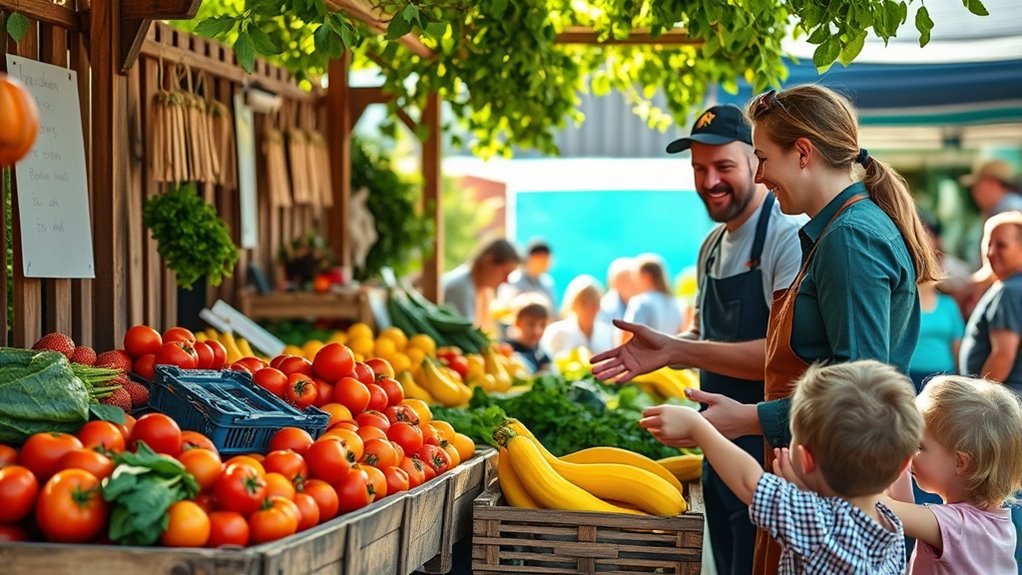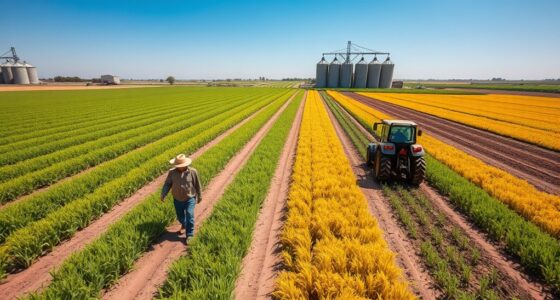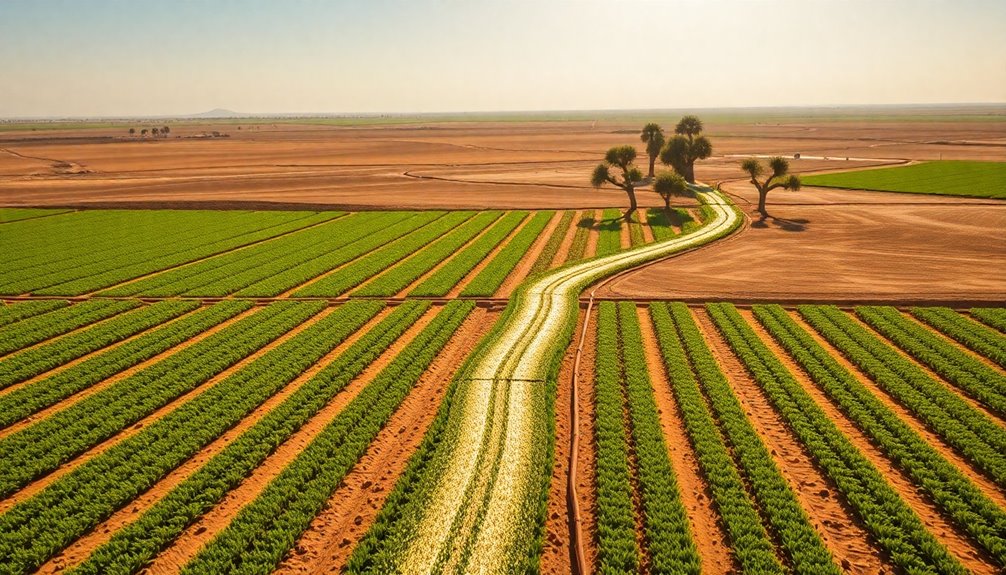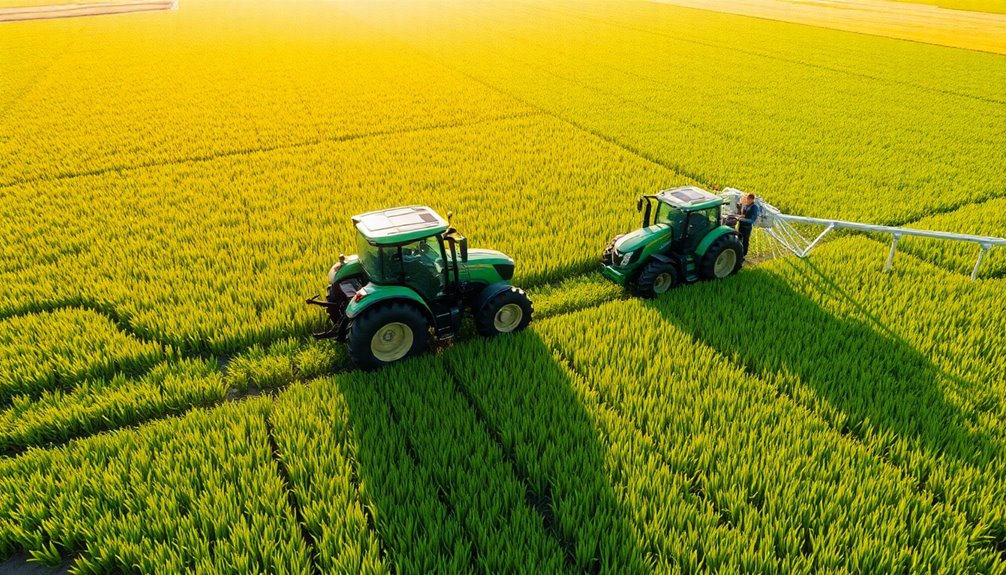To market your farm products locally, start by understanding your target audience and building a strong brand. Engage directly with consumers at farmers markets and consider joining a Community Supported Agriculture (CSA) program. Establish farm-to-table partnerships with local restaurants and businesses. Use social media to showcase your offerings and connect with your community. Create an email marketing strategy to keep customers informed and participate in local events to boost visibility. There's much more you can explore to elevate your farm's presence!
Key Takeaways
- Identify your target market by researching local demographics and consumer preferences to tailor your offerings effectively.
- Engage with the community through farmers markets and CSA programs to build relationships and encourage repeat purchases.
- Establish farm-to-table partnerships with local restaurants and grocery stores to ensure a steady income stream and enhance brand visibility.
- Leverage social media platforms to showcase your products, share engaging content, and connect with potential customers.
- Create an email marketing strategy to keep customers informed about crop availability, promotions, and local events related to your farm.
Understand Your Target Market
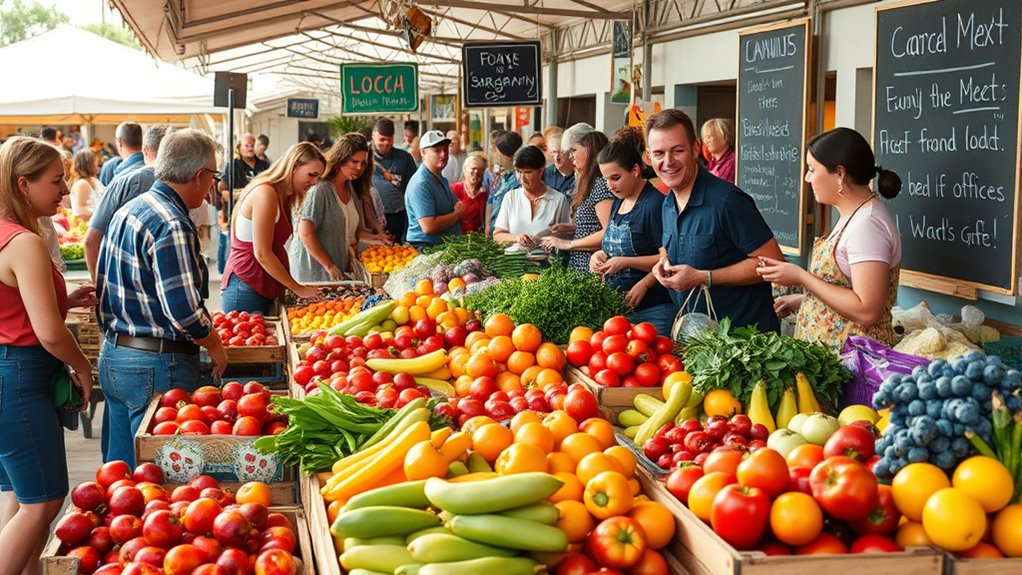
Understanding your target market is essential for effective local marketing. You need to identify specific demographics like age, income levels, and local food trends to tailor your approach. Conducting thorough market research allows you to analyze local competition and consumer preferences, helping you differentiate your products.
Whether you choose direct-to-consumer or wholesale sales channels, understanding these nuances is vital for targeting the right customer segments. Building relationships with local consumers and businesses fosters trust and loyalty, enhancing their overall experience and encouraging repeat purchases.
Build a Strong Farm Brand
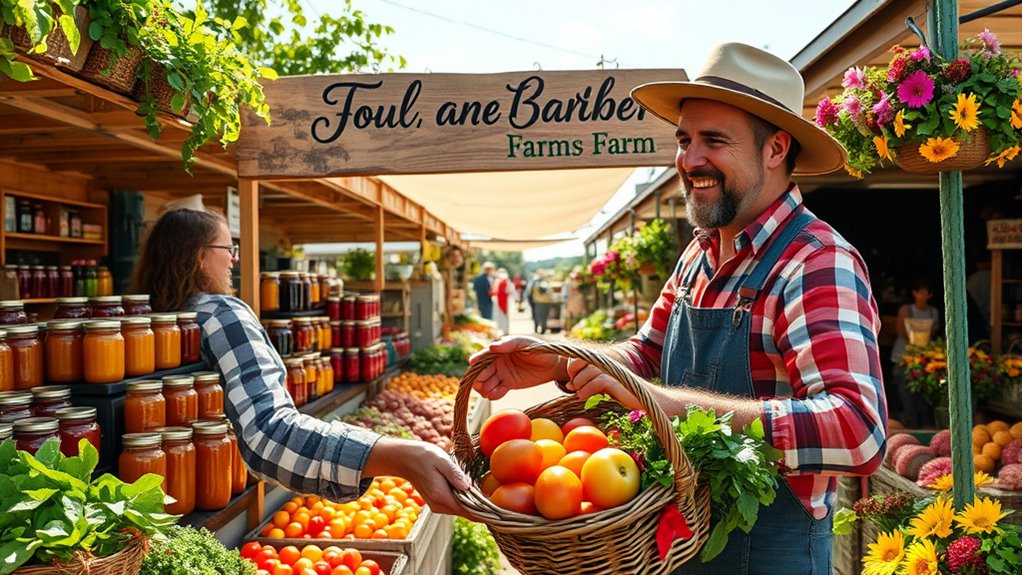
To stand out in a crowded market, you need to define your unique identity and create a memorable brand.
Consistent messaging across all platforms helps reinforce your story and values, making it easier for customers to connect with you.
Don't underestimate the power of visual branding elements; they can attract attention and leave a lasting impression on potential buyers.
Define Your Unique Identity
Creating a strong farm brand starts with defining your unique identity. This involves crafting a compelling logo and visual elements that reflect your farm's values and story, helping you stand out in a crowded market.
By understanding your target demographic, you can develop tailored marketing strategies that resonate with local consumers, making your brand relatable and appealing. Engaging in community events and farmers markets allows you to build relationships and solidify your reputation directly with potential customers.
Don't forget to utilize customer feedback to refine your messaging and product offerings. This will strengthen brand perception and encourage brand loyalty, ensuring that your unique identity isn't only recognized but celebrated in your community. Additionally, fostering emotional well-being through your farm's mission can create a deeper connection with your customers, enhancing their loyalty and support.
Consistent Messaging Across Platforms
While you establish your farm's brand, ensuring consistent messaging across all platforms is essential for reinforcing your identity. This cohesive approach helps customers recognize and remember your farm's story and values.
Whether you're at farmers markets or engaging through social media platforms, maintaining uniform messaging builds trust and credibility, leading to customer loyalty. Share engaging stories about your farm's practices and products to foster emotional connections that set you apart from competitors.
Utilize local marketing strategies alongside email newsletters to deliver the same core messages consistently. This not only enhances brand recognition but also keeps customers informed about offerings and updates, creating a strong foundation for your farm's success. Additionally, consider hosting cultural festivals that celebrate local heritage, which can further connect your farm to the community.
Visual Branding Elements Matter
Your farm's visual branding elements play a significant role in establishing a strong identity that resonates with customers.
To build an effective marketing strategy, focus on the following:
- Distinctive Logos: Create a memorable logo that reflects your farm's values and mission.
- Attractive Packaging: Make sure your packaging isn't only eye-catching but also communicates quality produce and complies with labeling requirements.
- Engaging Visuals: Use intriguing visuals in your marketing materials and social media to enhance engagement and draw in potential customers.
- Storytelling: Share your farm's story through visuals, showcasing your commitment to quality and fostering customer trust and loyalty. Additionally, leveraging social media platforms can amplify your brand reach and engage with a wider audience.
Utilize Farmers Markets
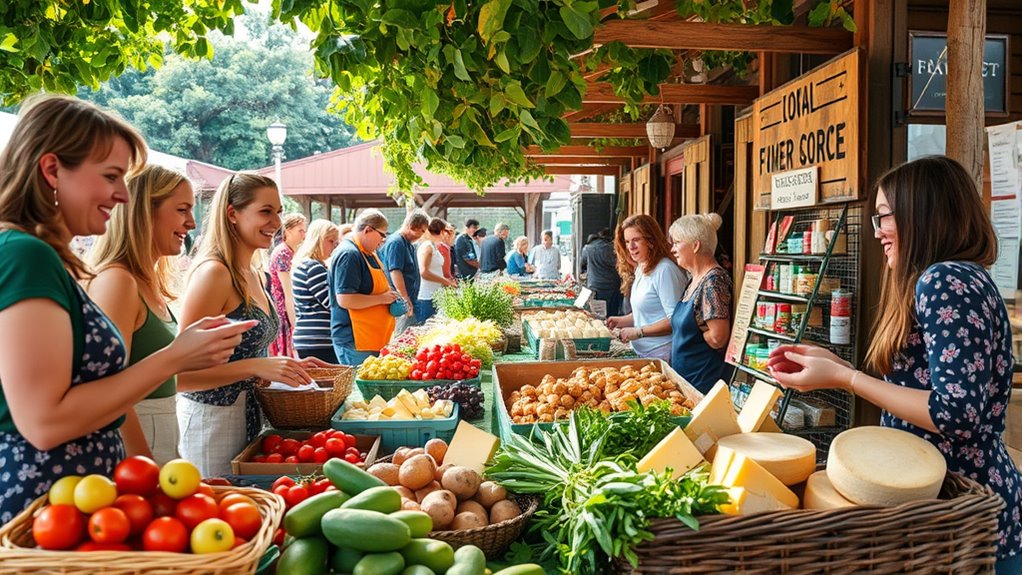
Farmers markets offer an excellent platform for connecting directly with local consumers, allowing you to build relationships that drive repeat purchases and customer loyalty. By participating in these markets, you can showcase your fresh produce and gather immediate feedback to improve your offerings. An attractive booth enhances visibility, making it easier for customers to find and appreciate your local products. Additionally, high-demand crops can help you attract more customers, ensuring that your products stand out in a competitive market.
| Benefits | Description | Impact on Sales |
|---|---|---|
| Direct Engagement | Connect with local consumers | Builds loyalty |
| Immediate Feedback | Adjust products based on preferences | Increases sales |
| Lower Overhead Costs | Retain more profit | Boosts income |
| Growing Demand | Leverage community interest in local | Enhances brand |
| Organized Booth | Attractive displays attract customers | Drives traffic |
Utilizing farmers markets is a smart sales channel for your marketing efforts.
Engage in Community Supported Agriculture (CSA)
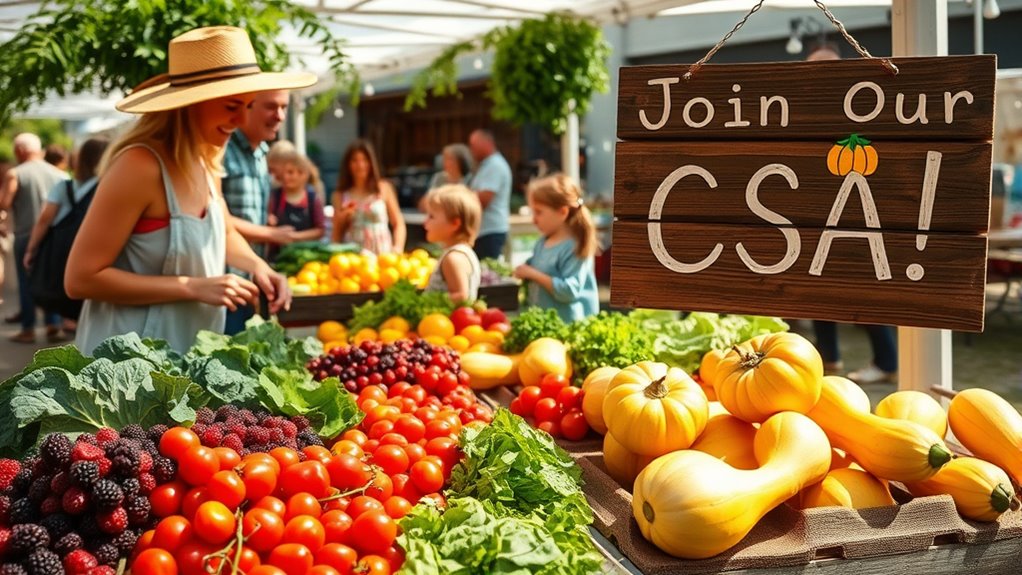
Engaging in Community Supported Agriculture (CSA) can considerably enhance your connection with local consumers, as it allows them to invest directly in your farm's success.
Here are some benefits of implementing a CSA program:
- Financial Stability: Upfront payments provide cash flow throughout the growing season.
- Customer Loyalty: Weekly boxes of fresh farm produce foster consistent interactions and deeper relationships.
- Seasonal Offerings: CSA programs increase awareness of what's in season, enticing customers with diverse options.
- Premium Prices: With dedicated customers, you can charge premium prices for high-quality, locally grown products.
Additionally, engaging in CSA can help you cultivate a strong sense of community connection, which is essential for fostering long-term customer relationships.
Establish Farm-to-Table Partnerships
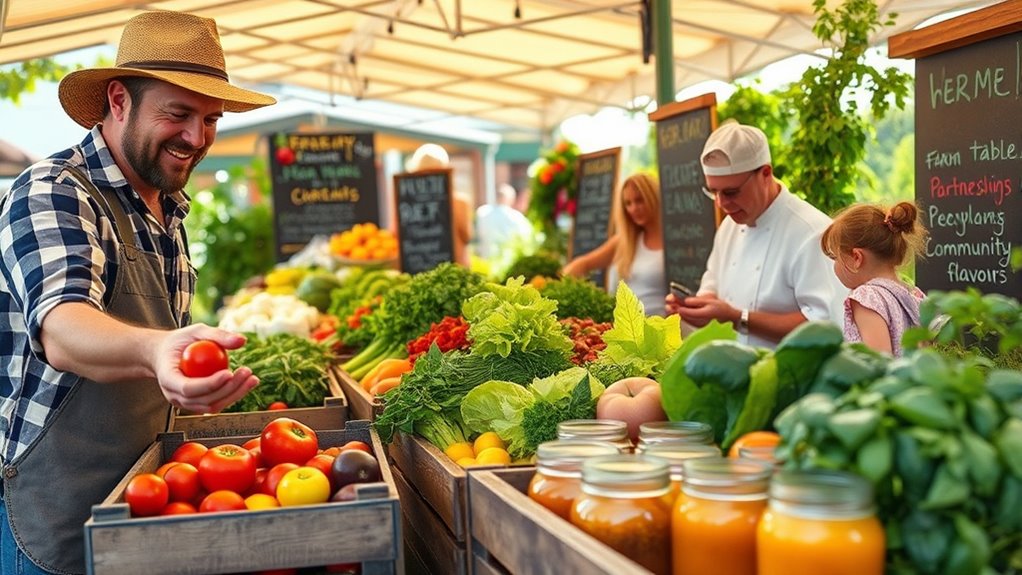
By establishing farm-to-table partnerships, you can create strong connections with local eateries that prioritize fresh, quality ingredients.
Collaborating with local businesses like restaurants, coffee shops, and caterers helps guarantee a consistent supply of your fresh produce, fostering mutual support and enhanced customer loyalty.
Partnering with local eateries ensures a steady supply of fresh produce while building community support and customer loyalty.
These partnerships often lead to steady income streams through regular orders as eateries seek high-quality, locally sourced ingredients for their menus.
Being associated with quality dining experiences boosts your farm's reputation and attracts customers enthusiastic to support local agriculture.
Educating consumers on the benefits of farm-to-table eating emphasizes sustainability and community support.
Joint marketing efforts, like featuring your produce on restaurant menus, can drive awareness and sales for both you and your partners. Additionally, financial considerations for supporting local farmers can enhance community partnerships and foster economic growth.
Leverage Social Media for Promotion
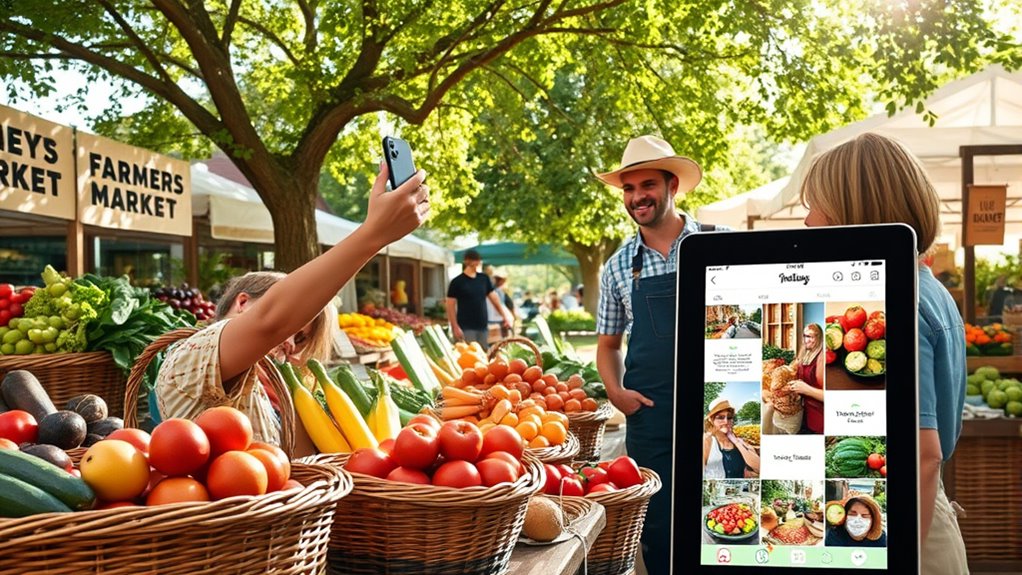
To effectively market your farm products, you need to choose the right social media platforms that resonate with your audience.
Engaging with your followers through regular posts and interactions can build a loyal customer base.
Make the most of these channels to showcase your offerings and keep your community informed about your farm activities.
Choose Right Platforms
Selecting the right social media platforms is essential for effectively marketing your farm products locally. You need to showcase your offerings where your audience spends their time. Here are four strategies to evaluate:
- Use Facebook and Instagram: These platforms are perfect for visually appealing content that highlights freshness and local availability.
- Post Engaging Content: Share recipes or behind-the-scenes glimpses to build a community and encourage interaction.
- Leverage Local Hashtags: Use geotags to enhance discoverability among consumers searching for local farm products.
- Create Targeted Ads: Tailor your ads to specific demographics, aligning your farm marketing with the interests of your local market.
These approaches not only boost visibility but also enhance customer loyalty by fostering a sense of connection.
Engage With Followers
Engaging with your followers is essential for building a loyal customer base and promoting your farm products effectively.
Use social media platforms like Facebook and Instagram to share eye-catching images and engaging stories about your farm. Regularly post updates, promotions, and seasonal offerings to maintain customer interest and encourage interaction.
Ask your followers to share their experiences with your products by using unique hashtags or tagging your farm, which can boost your reach through organic word-of-mouth marketing.
Hosting live Q&A sessions or virtual farm tours can create a personal connection and educate your audience.
Keep an eye on social media metrics to understand what resonates, allowing you to adjust your strategy and better engage with followers in your local market.
Create an Email Marketing Strategy

Building an effective email marketing strategy can be a game changer for promoting your farm products locally. Here are four essential steps to get you started:
- Build an email list: Collect addresses through your website, farmers markets, and in-person interactions to target your audience effectively.
- Send regular newsletters: Keep customers informed about crop availability, seasonal offerings, and special promotions to maintain engagement.
- Utilize compelling subject lines: Personalize your emails to boost open rates; studies show that tailored content can enhance click-through rates by 14%.
- Segment your list: Based on customer preferences and purchasing history, tailor your messaging to improve relevance and conversion rates. Additionally, regularly cleaning your email list helps maintain engagement and improves email deliverability.
Participate in Local Events and Activities

Email marketing is a great way to keep your customers informed, but connecting with your community through local events can take your farm's visibility to the next level.
Participating in local farmers markets lets you engage directly with customers, build brand awareness, and form lasting relationships within the community.
Events like food festivals and fairs provide a platform to showcase your products, educate consumers about local produce, and enhance your farm's reputation.
Hosting on-farm activities, such as harvest festivals, encourages community involvement and can create additional revenue streams.
By getting involved in community-supported agriculture initiatives, you guarantee a steady customer base while promoting the benefits of local food.
These connections can lead to increased sales and loyal customers for your farm. Additionally, fostering community relationships can enhance quality of life for local seniors, as they often seek fresh produce and social engagement opportunities.
Collaborate With Local Businesses
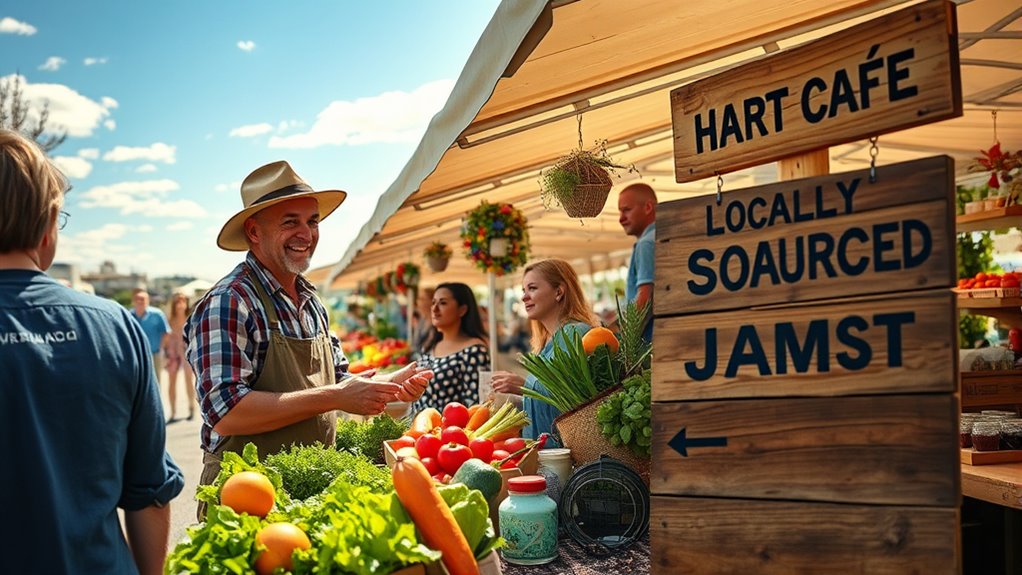
When you collaborate with local businesses, you not only expand your reach but also create a network that supports your farm's growth.
Here are four effective ways to boost your farm's marketing:
- Partner with restaurants to showcase your produce in their farm-to-table options, enhancing brand visibility.
- Supply local grocery stores with fresh products, ensuring a consistent revenue stream and meeting rising demand.
- Engage in joint marketing efforts, like cross-promotions or co-hosted community events, to amplify your reach and strengthen local ties.
- Participate in community events as a sponsor to enhance brand awareness and demonstrate your commitment to local economic development, helping to increase sales and customer loyalty. Additionally, collaborating with local businesses can lead to unique experiences for customers, such as family-friendly activities that create lasting memories.
Frequently Asked Questions
How Will You Market Your Local Agricultural Products?
You'll market your local agricultural products by connecting directly with customers at farmers markets, fostering relationships that build trust.
You can implement a Community Supported Agriculture program to guarantee steady income and loyal clientele.
Using social media, you'll showcase your unique offerings and engage with your audience.
Collaborating with local restaurants and grocery stores can expand your reach, while conducting market research helps you understand what your community wants and needs.
How Do Local Farmers Sell Their Products?
Local farmers sell their products in various ways.
You might set up a stand at farmers markets, directly connecting with customers and building community ties.
You could also create a Community Supported Agriculture (CSA) program, offering weekly boxes of fresh produce for upfront payments.
Partnering with restaurants and grocery stores is another option, ensuring consistent sales.
Don't forget about social media—it's a powerful tool to reach more people and showcase what you offer.
How Do I Set up a Local Farmers Market?
To set up a local farmers market, start by researching local regulations and securing any necessary permits.
Choose a market that fits your needs, considering location, fees, and product saturation.
Create an attractive display to draw in customers and showcase your offerings.
Engage with shoppers by sharing your farm's story and offering samples.
Finally, listen to customer feedback to refine your products and maintain a strong market presence.
What Sells Best at a Farmers Market?
You might think that only traditional produce sells well at farmers markets, but that's not the case.
Fresh, seasonal items like tomatoes and leafy greens attract enthusiastic shoppers, while unique heirloom varieties spark curiosity.
Value-added products, like jams and baked goods, often command higher prices too.
Don't forget prepared meals or snacks—they cater to convenience-seeking consumers.
Conclusion
By marketing your farm products locally, you're not just selling food; you're building relationships and creating a community around your brand. You might worry that competing with bigger stores is tough, but imagine the joy on a family's face as they bite into a fresh, juicy tomato they bought directly from you. That connection is priceless and can transform your farm into a local favorite. So roll up your sleeves, get involved, and watch your farm thrive!

